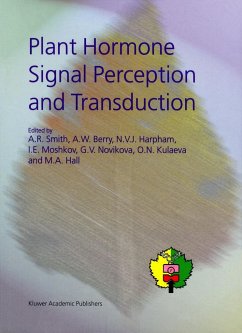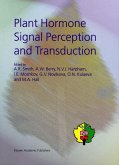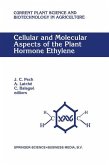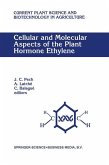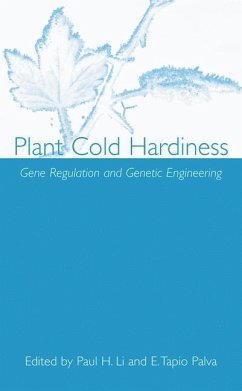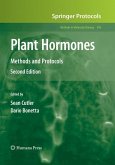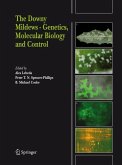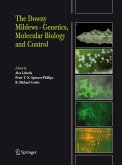A.R. Smith / A.W. Berry / N.V.J. Harpham / I.E. Moshkov / G.V. Novikova / O.N. Kulaeva / M.A. Hall (eds.)Proceedings of the International Symposium on Plant Hormone Signal Perception and Transduction, Moscow, Russia, September 4-10, 1994
Plant Hormone Signal Perception and Transduction
Proceedings of the International Symposium on Plant Hormone Signal Perception and Transduction, Moscow, Russia, September 4-10, 1994
Herausgegeben von Smith, A.R.; Berry, A.W.; Harpham, N.V.J.; Moshkov, I.E.; Novikova, G.V.
Schade – dieser Artikel ist leider ausverkauft. Sobald wir wissen, ob und wann der Artikel wieder verfügbar ist, informieren wir Sie an dieser Stelle.
A.R. Smith / A.W. Berry / N.V.J. Harpham / I.E. Moshkov / G.V. Novikova / O.N. Kulaeva / M.A. Hall (eds.)Proceedings of the International Symposium on Plant Hormone Signal Perception and Transduction, Moscow, Russia, September 4-10, 1994
Plant Hormone Signal Perception and Transduction
Proceedings of the International Symposium on Plant Hormone Signal Perception and Transduction, Moscow, Russia, September 4-10, 1994
Herausgegeben von Smith, A.R.; Berry, A.W.; Harpham, N.V.J.; Moshkov, I.E.; Novikova, G.V.
- Gebundenes Buch
- Merkliste
- Auf die Merkliste
- Bewerten Bewerten
- Teilen
- Produkt teilen
- Produkterinnerung
- Produkterinnerung
Studies of the perception and transduction of hormonal signals in higher plants are relatively recent. Despite the rather small number of researchers involved in comparison, say, to those studying signalling in animals, plant scientists are becoming attracted to this important field because of the fascinating mechanisms being revealed and the recognition that any hope of understanding the ways in which the growth and development of the whole plant are controlled can only be based on an exploration of the physiology, biochemistry and molecular biology of these mechanisms. The Moscow symposium…mehr
Andere Kunden interessierten sich auch für
![Plant Hormone Signal Perception and Transduction Plant Hormone Signal Perception and Transduction]() Plant Hormone Signal Perception and Transduction83,99 €
Plant Hormone Signal Perception and Transduction83,99 €![Cellular and Molecular Aspects of the Plant Hormone Ethylene Cellular and Molecular Aspects of the Plant Hormone Ethylene]() PechCellular and Molecular Aspects of the Plant Hormone Ethylene161,99 €
PechCellular and Molecular Aspects of the Plant Hormone Ethylene161,99 €![Cellular and Molecular Aspects of the Plant Hormone Ethylene Cellular and Molecular Aspects of the Plant Hormone Ethylene]() Cellular and Molecular Aspects of the Plant Hormone Ethylene161,99 €
Cellular and Molecular Aspects of the Plant Hormone Ethylene161,99 €![Plant Cold Hardiness Plant Cold Hardiness]() Paul H. Li / E. Tapio Palva (Hgg.)Plant Cold Hardiness81,99 €
Paul H. Li / E. Tapio Palva (Hgg.)Plant Cold Hardiness81,99 €![Plant Hormones Plant Hormones]() Plant Hormones116,99 €
Plant Hormones116,99 €![The Downy Mildews - Genetics, Molecular Biology and Control The Downy Mildews - Genetics, Molecular Biology and Control]() The Downy Mildews - Genetics, Molecular Biology and Control116,99 €
The Downy Mildews - Genetics, Molecular Biology and Control116,99 €![The Downy Mildews - Genetics, Molecular Biology and Control The Downy Mildews - Genetics, Molecular Biology and Control]() The Downy Mildews - Genetics, Molecular Biology and Control116,99 €
The Downy Mildews - Genetics, Molecular Biology and Control116,99 €-
-
-
Studies of the perception and transduction of hormonal signals in higher plants are relatively recent. Despite the rather small number of researchers involved in comparison, say, to those studying signalling in animals, plant scientists are becoming attracted to this important field because of the fascinating mechanisms being revealed and the recognition that any hope of understanding the ways in which the growth and development of the whole plant are controlled can only be based on an exploration of the physiology, biochemistry and molecular biology of these mechanisms.
The Moscow symposium that gave rise to the present book drew many of the most active workers in the area, and many new developments were revealed.
Audience: Important reading for all those interested in plant growth and development.
The Moscow symposium that gave rise to the present book drew many of the most active workers in the area, and many new developments were revealed.
Audience: Important reading for all those interested in plant growth and development.
Produktdetails
- Produktdetails
- Verlag: Springer Netherlands / Springer, Berlin
-
- Seitenzahl: 230
- Erscheinungstermin: 31. Juli 1996
- Englisch
- Abmessung: 260mm x 195mm
- Gewicht: 814g
- ISBN-13: 9780792337683
- ISBN-10: 0792337689
- Artikelnr.: 24504534
- Herstellerkennzeichnung
- Libri GmbH
- Europaallee 1
- 36244 Bad Hersfeld
- gpsr@libri.de
- Verlag: Springer Netherlands / Springer, Berlin
-
- Seitenzahl: 230
- Erscheinungstermin: 31. Juli 1996
- Englisch
- Abmessung: 260mm x 195mm
- Gewicht: 814g
- ISBN-13: 9780792337683
- ISBN-10: 0792337689
- Artikelnr.: 24504534
- Herstellerkennzeichnung
- Libri GmbH
- Europaallee 1
- 36244 Bad Hersfeld
- gpsr@libri.de
1. Molecular analysis of auxin-specific signal transduction; M.A. Venis, et al. 2. Partial purification and kinetic characterisation of an auxin-binding activity in cytoplasmic extracts of rape seed, Brassica napus L., hypocotyls; K. Jørgensen, S.V.S. Nielsen. 3. Expression of an auxin-inducible promoter of tobacco in Arabidopsis thaliana; D.A.M. van der Kop, et al. 4. The heterogeneity of the plasma membrane H+-ATPase response to auxin: an alternate way to analyze signal perception and transduction? F. Masson, et al. 5. Elementary auxin response chains at the plasma membrane involve external abp1 and multiple electrogenic ion transport proteins; H. Barbier-Brygoo, et al. 6. Plant hormone receptors: from binding proteins to fluctional units; D. Klämbt. 7. Regulation of a class of auxin-induced genes in cell-suspension cultures from Nicotiana tabacum; C.J.M. Boot, et al. 8. The IAA-influx carrier at the plasmalemma: properties, regulation and function in auxin transduction; B. Zbell. 9. Cytokinin signalling systems: from a whole plant to the molecular level; O.N. Kulaeva, et al. 10. Zeatin-binding proteins participating in cytokinin-dependent activation of transcription; N.N. Karavaiko, et al. 11. A cytokinin-binding protein from tobacco leaves: the 57 kDa subunit has high homology to S-adenosyl-L-homocysteine hydrolase; S. Mitsui, et al. 12. Photoaffinity labelling of a cytokinin-binding integral protein in plant mitochondria; C. Brinegar, et al. 13. Specific photoaffinity labelling of a thylakoid membrane protein with an azido-cytokinin agonist; F. Nogué, et al. 14. Isolation and characterisation of cDNAs for cytokinin-repressed genes; H. Teramoto, et al. 15. Cytokinin and abscisic acid in regulation of chloroplast protein gene expression and photosynthetic activity; V.V. Kuznetsov, et al. 16. Ethylene binding sites in higher plants; N.V.J. Harpham, et al. 17. Effect of 1-methylcyclopropene and methylenecyclopropene on ethylene binding and ethylene action on cut carnations; E.C. Sisler. 18. Regulation of the expression of plant defence genes; J.F. Bol, et al. 19. Fusicoccin and its receptors: perception and signal transduction; P. Aducci, et al. 20. 14-3-3 Protein homologues play a central role in the fusicoccin signal transduction pathway; A. de Boer, et al. 21. Endogenous fusicoccin: receptors and ligands; G.S. Muromtsev. 22. Different properties of the inward rectifying potassium conductance of aleurone protoplasts from dormant and non-dormant barley grains; B. van Duijn, et al. 23. Effect of an alien ipt gene on hormonal concentrations of plants; R.V. Makarova, et al. 24. Abscisic acid-induced gene expression requires the activity of protein(s) sensitive to the protein-tyrosine phosphatase inhibitor, phenylarsine oxide; S. Heimovaara-Dijkstra, et al. 25. Auxin activation of phospholipase A2 the generated lipids, and the function of lipid-activated protein kinase; G.F.E. Scherer. 26. Phospholipid signalling and lipid-derived second messengers in plants; G. Scherer. 27. Site-directed mutagenesis of the cGMP phosphodiesterase inhibitory &ggr; subunit from bovine rods:
1. Molecular analysis of auxin-specific signal transduction; M.A. Venis, et al. 2. Partial purification and kinetic characterisation of an auxin-binding activity in cytoplasmic extracts of rape seed, Brassica napus L., hypocotyls; K. Jørgensen, S.V.S. Nielsen. 3. Expression of an auxin-inducible promoter of tobacco in Arabidopsis thaliana; D.A.M. van der Kop, et al. 4. The heterogeneity of the plasma membrane H+-ATPase response to auxin: an alternate way to analyze signal perception and transduction? F. Masson, et al. 5. Elementary auxin response chains at the plasma membrane involve external abp1 and multiple electrogenic ion transport proteins; H. Barbier-Brygoo, et al. 6. Plant hormone receptors: from binding proteins to fluctional units; D. Klämbt. 7. Regulation of a class of auxin-induced genes in cell-suspension cultures from Nicotiana tabacum; C.J.M. Boot, et al. 8. The IAA-influx carrier at the plasmalemma: properties, regulation and function in auxin transduction; B. Zbell. 9. Cytokinin signalling systems: from a whole plant to the molecular level; O.N. Kulaeva, et al. 10. Zeatin-binding proteins participating in cytokinin-dependent activation of transcription; N.N. Karavaiko, et al. 11. A cytokinin-binding protein from tobacco leaves: the 57 kDa subunit has high homology to S-adenosyl-L-homocysteine hydrolase; S. Mitsui, et al. 12. Photoaffinity labelling of a cytokinin-binding integral protein in plant mitochondria; C. Brinegar, et al. 13. Specific photoaffinity labelling of a thylakoid membrane protein with an azido-cytokinin agonist; F. Nogué, et al. 14. Isolation and characterisation of cDNAs for cytokinin-repressed genes; H. Teramoto, et al. 15. Cytokinin and abscisic acid in regulation of chloroplast protein gene expression and photosynthetic activity; V.V. Kuznetsov, et al. 16. Ethylene binding sites in higher plants; N.V.J. Harpham, et al. 17. Effect of 1-methylcyclopropene and methylenecyclopropene on ethylene binding and ethylene action on cut carnations; E.C. Sisler. 18. Regulation of the expression of plant defence genes; J.F. Bol, et al. 19. Fusicoccin and its receptors: perception and signal transduction; P. Aducci, et al. 20. 14-3-3 Protein homologues play a central role in the fusicoccin signal transduction pathway; A. de Boer, et al. 21. Endogenous fusicoccin: receptors and ligands; G.S. Muromtsev. 22. Different properties of the inward rectifying potassium conductance of aleurone protoplasts from dormant and non-dormant barley grains; B. van Duijn, et al. 23. Effect of an alien ipt gene on hormonal concentrations of plants; R.V. Makarova, et al. 24. Abscisic acid-induced gene expression requires the activity of protein(s) sensitive to the protein-tyrosine phosphatase inhibitor, phenylarsine oxide; S. Heimovaara-Dijkstra, et al. 25. Auxin activation of phospholipase A2 the generated lipids, and the function of lipid-activated protein kinase; G.F.E. Scherer. 26. Phospholipid signalling and lipid-derived second messengers in plants; G. Scherer. 27. Site-directed mutagenesis of the cGMP phosphodiesterase inhibitory &ggr; subunit from bovine rods:

